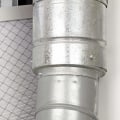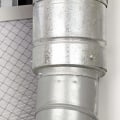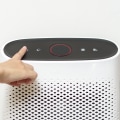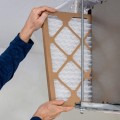MERV 8 Air Filters
Air filters play a crucial role in improving indoor air quality and protecting occupants from harmful airborne contaminants. Among the different types of air filters available on the market, MERV 8 air filters are widely used for their ability to capture a wide range of particles, including pollen, dust mites, pet dander, and other common allergens. These filters are designed to trap small particles that can cause respiratory problems or aggravate existing health conditions.
Understanding the principles behind MERV ratings is essential when selecting an appropriate filter for your needs. The Minimum Efficiency Reporting Value (MERV) rating system measures a filter's effectiveness in capturing particles of different sizes. Filters with higher MERV ratings have greater particle-capturing capacity but also tend to restrict airflow more than lower-rated ones. In this article, we will explore how MERV 8 filters work, their benefits over other types of air filters, and important considerations when choosing and maintaining them for optimal performance.
Understanding MERV Ratings
The understanding of MERV ratings is essential for making informed decisions about air filters, as it determines the filter's ability to capture particles and protect against airborne pollutants. MERV stands for Minimum Efficiency Reporting Value, which refers to a rating system that measures how effective an air filter is at capturing particles ranging from 0.3 to 10 microns in size. The higher the MERV rating, the more efficient the filter is at capturing these particles.
MERV ratings range from 1 to 20, with higher numbers indicating better filtration efficiency levels. A MERV 8 air filter, for example, can capture particles such as pollen, pet dander, and dust mites at a rate of up to 70%. It can also trap mold spores and bacteria at a lower rate of around 20-30%. However, it may not be effective in capturing smaller particulate matter such as smoke or viruses.
It's important to note that while high MERV-rated filters offer better filtration performance, they can also impede airflow and strain HVAC systems if not properly maintained. It's recommended to consult with an HVAC professional or refer to manufacturer recommendations when choosing an appropriate MERV-rated filter for your home or business. Understanding MERV ratings can help ensure optimal indoor air quality and protect against harmful airborne pollutants.
How MERV 8 Filters Work
One of the primary functions of MERV 8 filters is to capture and remove small airborne particles from the air. These filters are designed to trap particles that are as small as three microns in size, which include dust mites, pollen, and pet dander. They are also effective at capturing larger particles such as mold spores and some types of bacteria.
The filtration efficiency of MERV 8 filters is measured by their ability to remove particles from the air. This rating system ranges from 1 to 16, with higher numbers indicating greater filtration efficiency. A MERV 8 filter typically has a filtration efficiency rate between 70% and 85%, making it an effective option for improving indoor air quality.
When using MERV 8 filters, it's important to note that they may need to be replaced more frequently than lower-rated filters due to their increased effectiveness at trapping airborne particles. However, the benefits of using these filters can outweigh any potential inconvenience or cost associated with replacement. Overall, MERV 8 filters provide a reliable and efficient way to improve indoor air quality by removing a wide range of airborne pollutants from the environment.
Benefits of MERV 8 Filters
Enhancing the quality of indoor air is achievable with the use of MERV 8 filters due to their ability to capture a wide range of airborne pollutants. These filters are designed to trap particles as small as 3 microns, including pollen, dust mites, pet dander, and mold spores. The benefits of using MERV 8 filters go beyond just improving indoor air quality.
Firstly, MERV 8 filters are energy efficient. They allow for proper airflow while still capturing a significant amount of pollutants. This means that your HVAC system doesn't have to work as hard to circulate air throughout your home or office space. As a result, you can save on energy costs and reduce your carbon footprint.
Secondly, MERV 8 filters are cost-effective in the long run. While they may be slightly more expensive than lower-rated filters upfront, they last longer and require fewer replacements over time. This means that you'll spend less money on filter replacements in the long run and enjoy better indoor air quality without breaking the bank.
Lastly, using MERV 8 filters can also help improve overall health and well-being by reducing exposure to harmful airborne particles. By trapping these pollutants before they enter your lungs or settle on surfaces in your home or office space, you can reduce symptoms associated with allergies and respiratory illnesses such as asthma. Overall, investing in high-quality MERV 8 air filters is an effective way to improve indoor air quality while also promoting energy efficiency and cost-effectiveness in the long run.
Choosing the Right Filter for Your Needs
Selecting an appropriate air filter that meets your specific needs is crucial for achieving optimal indoor air quality. When selecting a MERV 8 air filter, it is important to consider the size of the filter and whether it fits your HVAC system. Custom sizes are available for those who require a non-standard size. Additionally, it is important to consider cost when choosing a MERV 8 filter. While higher MERV ratings may provide better filtration, they often come at a higher cost.
When choosing a MERV 8 air filter, it is important to ensure that the filter fits your HVAC system properly. Custom sizes are available from some manufacturers for those who require filters in non-standard sizes. It is also worth noting that not all HVAC systems are compatible with every type of filter material; therefore, consulting with an expert before making any purchase decisions can save you money in the long run.
While higher-rated filters (such as those above MERV 8) may offer better indoor air quality, they often come at an increased cost compared to their lower-rated counterparts. If you have concerns about your indoor air quality and want better filtration without breaking the bank, then a MERV 8-rated filter may be the best choice for you. However, if you suffer from allergies or respiratory issues or live in areas with high levels of pollutants such as smoke or pollen, then considering higher-rated filters may be necessary to maintain healthy indoor air quality.
Installation and Maintenance
Proper installation and maintenance of HVAC filters are crucial for ensuring optimal indoor air quality. One important factor to consider is the filter lifespan, which varies depending on the type of filter and its usage. Generally, MERV 8 air filters have a lifespan of three months but could last longer if maintained properly. It is important to replace filters when they become clogged with dirt, dust, and other particles as it can reduce their effectiveness in capturing pollutants.
When replacing filters, there are cost-effective options available that provide excellent filtration performance. For example, pleated paper filters can be an affordable option that effectively captures larger particles while allowing better airflow than traditional fiberglass filters. Another option is reusable electrostatic filters that do not need frequent replacement and can be washed and reused multiple times before needing replacement.
Maintaining clean air filtration systems also involves regular cleaning or replacement of other system components such as coils and ductwork. Dirty coils or ducts can harbor bacteria, mold spores, and other harmful particles that can contaminate indoor air. By following proper installation procedures and maintaining the system regularly, one can ensure optimal indoor air quality while extending the life of HVAC equipment.
Other Types of Air Filters
Electrostatic filters offer a reusable and cost-effective alternative for maintaining high indoor air quality. Unlike disposable filters, electrostatic filters are washable and can be used repeatedly. These types of filters use an electric charge to trap particles in the air. The filter attracts particles with an opposite charge, allowing them to stick to the filter material.
HEPA (High-Efficiency Particulate Air) filters are another type of air filter that is commonly used in homes and businesses. These types of filters are highly effective at removing small particles from the air, such as pollen, dust mites, and pet dander. HEPA filters work by using a dense mesh to trap particles as they pass through the filter.
Washable versus disposable air filters are another consideration when choosing the right type of filter for your home or business. Washable filters can be reused multiple times after being cleaned, making them more economical than disposable options. Disposable filters need to be replaced regularly but do not require any maintenance beyond replacement. Ultimately, the choice between washable or disposable depends on personal preference and lifestyle factors such as time available for cleaning and budget constraints.
Common Airborne Contaminants
Airborne contaminants are a major concern for indoor air quality, as they can negatively impact human health and well-being. These contaminants originate from various sources such as combustion processes, building materials, and household products. The following list provides examples of common airborne contaminants found in indoor environments:
Volatile Organic Compounds (VOCs) - are emitted by cleaning agents, paints, adhesives, and other household products.
Particulate Matter (PM) - includes dust, pollen, and other microscopic particles that are suspended in the air.
Biological Contaminants - include bacteria, viruses, mold spores, and pet dander.
Carbon Monoxide (CO) - is produced by fuel-burning appliances such as stoves or furnaces.
Exposure to these contaminants can lead to various health effects ranging from minor irritations to serious respiratory illnesses or even cancer in some cases. Air filters play a crucial role in reducing the concentration of these airborne pollutants indoors by trapping them within their filter media before they can circulate in the room again.
However, it is important to note that while air filters are effective at capturing certain types of pollutants like PM and biological contaminants; VOCs and CO require specialized filtration systems for complete removal. Additionally, air filter effectiveness may vary depending on factors such as filter quality and maintenance frequency among others; therefore regular upkeep is necessary for optimal performance.
Air Quality Testing
Indoor air quality testing is essential for identifying potential health hazards in any indoor environment. The presence of indoor pollutants such as mold, bacteria, and volatile organic compounds can cause adverse health effects if not detected and addressed. These pollutants are known to cause respiratory problems, allergies, headaches, and other symptoms that can significantly impact the occupants' well-being.
There are various methods used in indoor air quality testing to identify the types and levels of pollutants present in a particular environment. One of the most common tests involves collecting air samples using specialized equipment that analyzes the concentration of contaminants. Other tests include surface sampling to detect mold or bacteria growth on surfaces and visual inspections to identify signs of water damage or poor ventilation.
The results from indoor air quality testing help determine appropriate measures to address any issues identified through the process. This may involve improving ventilation systems, removing sources of pollution such as mold or mildew growths, or implementing filtration systems like MERV 8 air filters to improve indoor air quality. Regular monitoring and maintenance can ensure continued healthy living conditions for all occupants.
Environmental Impact
Air filters play a crucial role in maintaining indoor air quality, but their use has a significant impact on the environment. The production and disposal of air filters contribute to carbon emissions and waste generation. Therefore, it is important to choose filters that have a low carbon footprint and are made from sustainable materials.
One way to reduce the environmental impact of air filters is by choosing MERV 8-rated filters. These filters are considered energy-efficient because they require less power to operate than higher-rated models. Also, MERV 8-rated filters are typically made from sustainable materials like recycled or renewable fibers that have minimal negative effects on the environment.
Reducing our carbon footprint and promoting sustainability should be at the forefront when selecting air filters. Choosing MERV 8-rated filters made from sustainable materials can help achieve these goals while still ensuring high indoor air quality standards. We must continue to explore innovative ways of producing and disposing of air filter products without compromising our environment's health and well-being.
Frequently Asked Questions
Can MERV 8 filters remove viruses from the air?
Air filtration is an important aspect of maintaining healthy indoor air quality. MERV 8 effectiveness, in terms of virus removal capabilities, depends on the size of the airborne particles and their electrostatic charge. While MERV 8 filters can capture some viruses, they may not be effective at capturing smaller viruses or those with a lower electrostatic charge.
In comparison with MERV 11 filters, which have a higher minimum efficiency reporting value (MERV) rating and can capture smaller airborne particles, including some viruses, MERV 8 filters may not provide the same level of protection against airborne pathogens. It is important to note that air filtration should be used as part of a comprehensive approach to maintaining indoor air quality and reducing the spread of infectious diseases.
How often should MERV 8 filters be replaced?
The frequency and lifespan of air filters depend on various factors such as the type of filter, the quality of air, and the usage pattern. Generally, it is recommended to replace air filters every 3 months or more frequently if you have pets or allergies. However, this duration can vary based on individual circumstances. For instance, high-traffic areas or industrial settings may require more frequent replacements due to increased particle accumulation.
It is important to follow manufacturer instructions for specific recommendations regarding filter replacement to avoid reducing filtration efficiency or causing damage to HVAC systems. Regularly replacing air filters not only improves indoor air quality but also prolongs the life of HVAC equipment by reducing strain on motors and improving energy efficiency.
Do MERV 8 filters work effectively in all types of HVAC systems?
Maintenance requirements and cost-effectiveness are key considerations when evaluating the efficacy of air filters in HVAC systems. The performance of an air filter depends on its ability to capture and remove airborne particles from the circulating air. While MERV 8 filters are effective in capturing a range of contaminants, including pollen, dust mites, and mold spores, their effectiveness may vary depending on the type of HVAC system being used.
For example, certain types of high-velocity systems may require more frequent filter replacements due to increased wear and tear on the filter media. Additionally, while MERV 8 filters offer a good balance between filtration efficiency and cost-effectiveness for many applications, higher-rated filters may be necessary for specialized environments or where there are health concerns related to indoor air quality. Ultimately, selecting an appropriate air filter requires consideration of factors such as maintenance requirements, cost-effectiveness, and specific HVAC system characteristics.
Can MERV 8 filters reduce odors in the home?
Air filters, in general, can help reduce odors in the home by trapping particles that contribute to unpleasant smells. However, the benefits of MERV 8 filters specifically in reducing odors have not been extensively studied or compared to other air filter options. It is important to note that MERV ratings do not directly correlate with odor reduction capabilities as they are primarily based on particle size filtration.
Other factors such as activated carbon or charcoal may be more effective at reducing specific odors. Therefore, while MERV 8 filters may provide some odor-reducing benefits, it is recommended to consider additional methods and technologies for addressing specific odor concerns in the home.
Are MERV 8 filters environmentally friendly?
Recyclability options and sustainable materials are two important factors to consider when evaluating the environmental friendliness of a product. Recyclability options refer to the ability of a product to be reused or repurposed after its initial use, reducing waste and minimizing the need for new resources. Sustainable materials, on the other hand, are those that are sourced and produced in a way that minimizes harm to the environment.
When considering these factors without the context of MERV 8 air filters specifically, it is important to note that there is no one-size-fits-all answer as different products may have different levels of recyclability and sustainability depending on their specific components and manufacturing processes. Therefore, it is necessary to evaluate each product individually based on these criteria to determine its overall environmental friendliness.
Conclusion
In conclusion, MERV 8 air filters are an effective way to improve the indoor air quality of your home or business. They work by capturing a wide range of airborne contaminants, from pollen and pet dander to mold spores and bacteria. MERV ratings provide a standardized system for comparing filters based on their efficiency at removing particles from the air.
When choosing a filter, it is important to consider factors such as the size of your HVAC system and the specific contaminants you are trying to remove. Proper installation and regular maintenance can also help ensure that your filter continues to perform effectively over time.
While MERV 8 filters offer many benefits, there are also other types of air filters available with different strengths and weaknesses. Additionally, it is important to recognize the potential environmental impact of using disposable filters and consider alternatives such as reusable options.
Overall, understanding the importance of indoor air quality and taking steps to improve it through proper filtration can lead to numerous health benefits for both individuals and communities.






